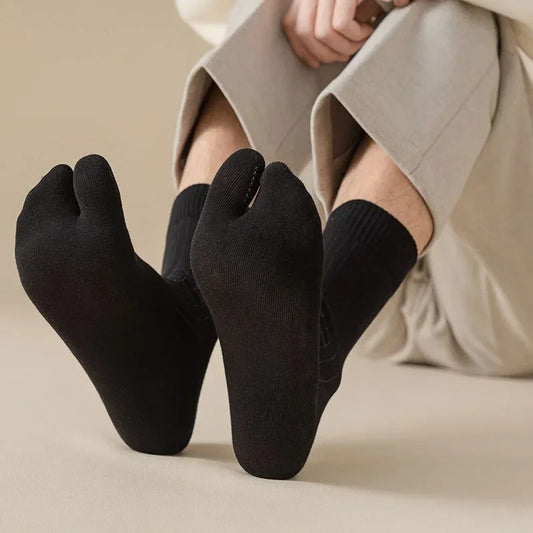Are Tabi Shoes Comfortable?
Tabi shoes, with their iconic split-toe design, often spark curiosity and questions. Originating from Japan, these uniquely shaped shoes offer a different walking experience compared to traditional Western footwear. But beyond their distinctive aesthetic, how comfortable are they really? It's a question worth exploring in depth, as footwear comfort directly affects our daily well-being, posture, and even foot health.
What Are Tabi Socks?
Tabi socks trace back to medieval Japan, traditionally worn with kimonos and sandals like geta or zori. They are characterized by a unique structure that separates the big toe from the others, creating a dedicated space that mirrors the natural shape of the foot.
This separation isn't just a stylistic choice—it's functionally purposeful. Isolating the big toe helps distribute body weight more evenly and activates intrinsic foot muscles. Traditional fabrics like cotton or silk offer breathability while maintaining stretch to accommodate foot movement.
Tabi socks typically reach the ankle or calf, providing gentle support without compressing circulation. This ancient design reveals an intuitive understanding of foot anatomy, predating modern insights on the importance of toe mobility.
Everyday Comfort Benefits of Tabi
Improved Stability and Balance
The big toe plays a vital role in body balance. By giving it its own space, Tabi shoes enhance its stabilizing function. This results in better proprioception, reduced fall risk, and a more grounded walking sensation—similar to barefoot walking. These qualities are particularly helpful for the elderly or those engaging in balance-focused activities.
💡 Note: A 7–10 day adjustment period is recommended to adapt to the altered pressure distribution.
Moisture Reduction and Thermal Comfort
The open structure of Tabi allows more air circulation around the toes, reducing moisture buildup. This natural ventilation lowers the risk of fungal infections and improves thermal comfort, especially in warm conditions.
Materials like cotton and bamboo help regulate temperature by absorbing and wicking away moisture, creating an ideal microclimate for the feet.
Prevention of Foot Deformities
The space for the big toe helps prevent common deformities like bunions (hallux valgus) or claw toes. Unlike tight-fitting shoes that compress toes, Tabi support natural toe alignment. For children, this can promote healthy foot development and prevent future issues.
Better Posture and Body Alignment
Tabi shoes influence overall posture by encouraging a natural foot position. This can reduce tension in the ankles, knees, and lower back. Many users report less back pain and a smoother walking experience—thanks to a gait pattern closer to barefoot walking.
Support for Sports and Movement
In sports like martial arts, Tabi are valued for grip and balance. Minimalist runners also appreciate their barefoot-like feel. Tabi activate underused foot muscles, strengthen the arch, and improve walking and running biomechanics.
Comfort of Different Tabi Types
Tabi Boots: Elegance Meets Support
Modern Tabi boots combine Japanese tradition with contemporary design. Their high shafts offer ankle support and stability, especially on uneven ground. The big toe separation reduces pressure points, while premium leather molds to the foot over time.
💡 Note: Not all Tabi are winter-ready. Choose lined, waterproof, or stiff leather models for better protection.
Everyday Tabi Shoes: Practical Ergonomics
Designed for daily use, these Tabi offer a balance of cushioning and flexibility. Their thicker soles cushion urban walking, and the split-toe design enhances grip on slippery or uneven surfaces.
Tabi Flats: Light and Flexible
Tabi ballet flats offer a lightweight, stylish alternative to standard flats. Their minimal structure allows free foot movement while reducing fatigue during long wear. Their flexibility promotes a smooth, natural gait—ideal for those sensitive to stiff shoes.
How to Choose the Right Tabi for Optimal Comfort
Materials by Season
- Summer: Favor breathable fabrics like cotton, linen, or bamboo.
- Winter: Opt for insulating materials like merino wool or fleece blends.
- All-Season: Hybrid materials combine natural breathability with synthetic durability.
Expert-Recommended Models
Podiatrists suggest mid-sole Tabi—neither too rigid nor too soft—for a natural foot roll with daily support. Models with light arch support suit people with flat feet or plantar fasciitis. For sports, reinforced heel/toe areas help absorb impact.
Tabi for Women, Men, and Children
Women’s Tabi often feature slimmer fits and more design variety. Men’s versions tend to prioritize durability and wider fits. For children, choose soft, growth-accommodating models—ideally with a little extra room to allow foot development.
💡 Tip: Choose a half-size up for kids to ensure natural toe spread and foot growth.
Conclusion: Lasting Comfort with Style
Tabi shoes offer a stylish and functional alternative to conventional footwear. Their foot-respecting design provides real benefits in comfort, posture, and foot health. With a wide range of models for everyday, professional, or athletic use, there’s a Tabi for every need.
Investing in a quality pair of Tabi is a sustainable choice for both comfort and wellness. This Japanese philosophy of foot care—where tradition meets innovation—offers a unique walking experience that’s increasingly embraced worldwide.
Tabi comfort goes beyond first impressions. It’s a holistic approach to well-being, improving posture, balance, and overall quality of life. A timeless concept, tailored for today.

